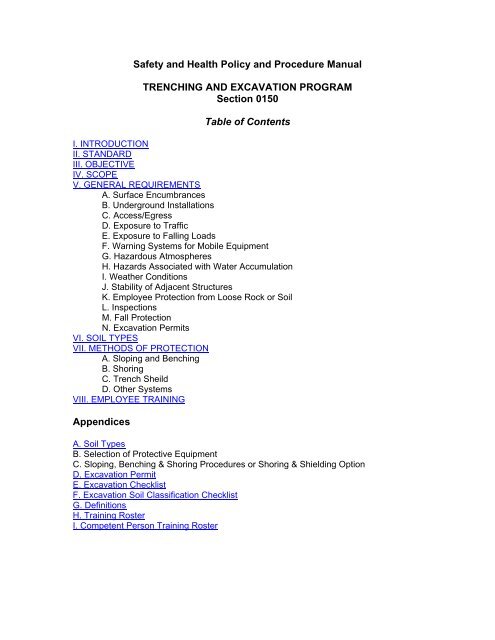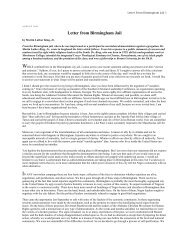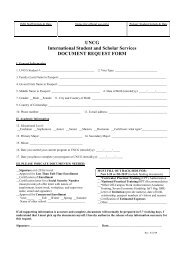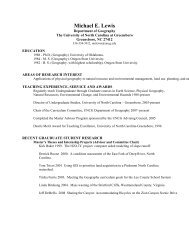Safety and Health Policy and Procedure Manual TRENCHING AND ...
Safety and Health Policy and Procedure Manual TRENCHING AND ...
Safety and Health Policy and Procedure Manual TRENCHING AND ...
Create successful ePaper yourself
Turn your PDF publications into a flip-book with our unique Google optimized e-Paper software.
<strong>Safety</strong> <strong>and</strong> <strong>Health</strong> <strong>Policy</strong> <strong>and</strong> <strong>Procedure</strong> <strong>Manual</strong><br />
<strong>TRENCHING</strong> <strong>AND</strong> EXCAVATION PROGRAM<br />
Section 0150<br />
Table of Contents<br />
I. INTRODUCTION<br />
II. ST<strong>AND</strong>ARD<br />
III. OBJECTIVE<br />
IV. SCOPE<br />
V. GENERAL REQUIREMENTS<br />
A. Surface Encumbrances<br />
B. Underground Installations<br />
C. Access/Egress<br />
D. Exposure to Traffic<br />
E. Exposure to Falling Loads<br />
F. Warning Systems for Mobile Equipment<br />
G. Hazardous Atmospheres<br />
H. Hazards Associated with Water Accumulation<br />
I. Weather Conditions<br />
J. Stability of Adjacent Structures<br />
K. Employee Protection from Loose Rock or Soil<br />
L. Inspections<br />
M. Fall Protection<br />
N. Excavation Permits<br />
VI. SOIL TYPES<br />
VII. METHODS OF PROTECTION<br />
A. Sloping <strong>and</strong> Benching<br />
B. Shoring<br />
C. Trench Sheild<br />
D. Other Systems<br />
VIII. EMPLOYEE TRAINING<br />
Appendices<br />
A. Soil Types<br />
B. Selection of Protective Equipment<br />
C. Sloping, Benching & Shoring <strong>Procedure</strong>s or Shoring & Shielding Option<br />
D. Excavation Permit<br />
E. Excavation Checklist<br />
F. Excavation Soil Classification Checklist<br />
G. Definitions<br />
H. Training Roster<br />
I. Competent Person Training Roster
Appendix A, Section 0150<br />
SOIL TYPES<br />
1. Stable Rock: This is natural solid mineral matter that can be excavated with vertical<br />
sides <strong>and</strong> remain intact.<br />
2. Type A: These are cohesive soils in which its unconfined compressive strength yields<br />
a result of 1.5 tons per square foot or greater. Type A soils may include clay, silty clay,<br />
s<strong>and</strong>y clay, <strong>and</strong> clay loam.<br />
No soil is Type A if it:<br />
• Is fissured<br />
• Is subject to vibration<br />
• Has been previously disturbed<br />
• Is part of a slope, layered system which dips into the excavation on a slope of 4<br />
horizontal to 1 vertical [4H:1V] or greater<br />
• Is subject to other factors requiring classification as less stable<br />
3. Type B: These are cohesive soils with an unconfined compressive strength yield of<br />
less than 1.5 tons per square foot, but more than 0.5 tons per square foot <strong>and</strong> also<br />
particular angular granular soils. Type B soils may include angular gravel, crushed rock,<br />
silt, <strong>and</strong> silt loam.<br />
Some characteristics of Type B soil are:<br />
• Granular cohesionless soils, e.g. gravel, silt, silt loam, s<strong>and</strong>y loam<br />
• Previously disturbed soils, except those otherwise classed as Type C<br />
• Type A fissured or subject to vibration<br />
• Unstable dry rock<br />
• Part of a sloped, layered system which dips into the excavation on a slope less<br />
steep than 4H:1V, but only if the material would otherwise be classified as Type<br />
B<br />
4. Type C: These are cohesive soils with an unconfined compressive strength of 0.5<br />
tons per square foot or less <strong>and</strong> cohesion less or submerged soils. Type C soils may<br />
include gravel, s<strong>and</strong>, loam, <strong>and</strong> submerged rock that is not stable.<br />
Some characteristics of Type C Soil are:<br />
• Submerged soil or soil from which water is freely seeping<br />
• Submerged rock that is not stable<br />
• Sloped, layered system which slopes into an excavation at an angle of 4H:1V or<br />
steeper<br />
Soil Testing<br />
Each soil <strong>and</strong> rock deposit shall be classified by a competent person as Stable Rock,<br />
Type A, B, C. Refer to Appendix F.
Basis of classification shall be made based on results of at least one visual <strong>and</strong> at least<br />
one manual analysis. These tests are described below:<br />
Visual Tests<br />
• Excavated soil: particle size <strong>and</strong> clumping<br />
• Excavation sides: cracks, spills layered systems<br />
• Adjacent areas: existing utility <strong>and</strong> other underground structures, previously<br />
disturbed soil, surface water, sources of vibration<br />
<strong>Manual</strong> Tests<br />
• Plasticity<br />
• Dry Strength<br />
• Thumb Penetration<br />
• Other Strength Tests<br />
• Drying Tests<br />
Definitions<br />
Cohesive Soil:<br />
• Clay or soil with a high clay content which has cohesive strength.<br />
• Does not crumble, can be excavated with vertical sides.<br />
• Plastic when moist, hard to break up when dry.<br />
• Clay, clayey silt, silty clay, organic clay, s<strong>and</strong>y clay<br />
Unconfined Compressive Strength:<br />
The load per unit area at which a soil will fail in compression. Estimated in the field by<br />
use of a pocket penetrometer, thumb penetration test, <strong>and</strong> other methods.<br />
Granular Soil:<br />
• Gravel, s<strong>and</strong>, or silt with little or no clay content.<br />
• No cohesive strength.<br />
Cannot be molded when moist <strong>and</strong> crumbles easily when dry<br />
Layered Systems:<br />
• Two or more distinctly different soil or rock arranged in layers<br />
• Micaceous seams or weakened planes in rock <strong>and</strong> shale<br />
• The system is classified according to its weaker layer, except where a more<br />
stable layer lies under a less stable layer
Appendix D, Section 0150<br />
THE UNIVERSITY OF NORTH CAROLINA at GREENSBORO<br />
EXCAVATION PERMIT<br />
Date:<br />
Organization: Facility: Location:<br />
Competent Person: Title: Telephone:<br />
Date Excavation to Begin:<br />
Person In Charge:<br />
Date Excavation to be Filled:<br />
Title:<br />
DESCRIPTION OF EXCAVATION:<br />
DESCRIPTION OF SPECIAL HAZARDS:<br />
EVALUATION BY COMPETENT PERSON<br />
No.<br />
Description<br />
1926.651 GENERAL REQUIREMENTS<br />
1. Surface Encumbrances.<br />
2. Underground installations.<br />
3. Access <strong>and</strong> egress (ramps).<br />
4. Means of egress from trenches.<br />
5. Exposure to vehicular traffic.<br />
6. Exposure to falling loads.<br />
7. Warning system for mobile equipment.<br />
8. Hazardous atmosphere.<br />
9. Emergency rescue equipment.<br />
10. Protection from hazards associated with water accumulation.<br />
11. Stability of adjacent structures.<br />
12. Protection from loose rock or soil.<br />
13. Inspections.<br />
1926.652 PROTECTIVE SYSTEMS<br />
14. Protection of employees.<br />
15. Design of sloping <strong>and</strong> benching.<br />
Design of support systems, shield system, <strong>and</strong> other protective<br />
16.<br />
system.<br />
17. Materials <strong>and</strong> equipment.<br />
Findings<br />
Action<br />
Taken
19. Sloping <strong>and</strong> benching system.<br />
20. Shield systems.<br />
SOIL CLASSIFICATION<br />
Cemented<br />
Cohesive<br />
Dry<br />
Fissured<br />
Granular<br />
Layered System<br />
Moist<br />
Plastic<br />
Saturated<br />
Stable Rock<br />
Submerged Soil<br />
SOIL TYPE (Complete) - BASIS OF CLASSIFICATION<br />
Stable Rock _______________________________________________________________<br />
Type A Soil_______________________________________________________________<br />
Type B Soil_______________________________________________________________<br />
Type C Soil_______________________________________________________________<br />
OTHER COMMENTS:<br />
COMPETENT PERSON<br />
SIGNATURE:_____________________________________<br />
TITLE: ____________________________ DATE
Appendix E, Section 0150<br />
THE UNIVERSITY OF NORTH CAROLINA at GREENSBORO<br />
EXCAVATION CHECKLIST<br />
Date:<br />
Organization: ____________________ Facility: ________________________<br />
Location: _________________________<br />
Excavation Description:<br />
Excavation By (Name):<br />
Title:<br />
Telephone:<br />
REQUIREMENTS FOR EXCAVATION<br />
No.<br />
1.<br />
SURFACE<br />
Surface encumbrances are removed or<br />
supported<br />
Item<br />
2. UNDERGROUND<br />
Underground utility installations have been<br />
determined prior to opening the excavation<br />
3.<br />
4.<br />
5.<br />
6.<br />
7.<br />
Exact location of underground installation<br />
has been determined<br />
Underground installation is protected, supported<br />
or removed while excavation is open<br />
Structural ramps are used solely be employees<br />
designed by a competent person<br />
Means of egress from trench excavations such<br />
as stairway, ladder, ramp, or other means are<br />
provided for 4-foot deep or more trench<br />
excavations <strong>and</strong> requires no more than 25 feet<br />
lateral travel to reach<br />
TRAFFIC<br />
Warning vests or similar high-visibility material<br />
are worn by employees exposed to vehicular<br />
traffic<br />
8. LOADS<br />
Employees are not permitted underneath loads<br />
h<strong>and</strong>led by lifting or diggin equipment<br />
WARNING SYSTEM FOR MOBILE EQUIPMENT<br />
A warning system such as barricades, h<strong>and</strong> <strong>and</strong><br />
mechanical signals, or stop logs is used when mobile<br />
9. equipment is operated adjacent to an excavation<br />
or required to approach the edge of the excavation<br />
<strong>and</strong> the operator does not have a clear <strong>and</strong> direct<br />
view of the edge of the excavation<br />
10. HAZARDOUS ATMOSPHERES<br />
Yes No<br />
Comments
Where hazardous atmosphere may exist such as oxygen<br />
deficiency <strong>and</strong>/or atmospheric contaminants or<br />
flammable gas, the atmosphere in the excavation is<br />
tested before employees enter<br />
EMERGENCY RESCUE EQUIPMENT<br />
Emergency rescue equipment, such as breathing<br />
11. apparatus, a safety harness <strong>and</strong> line, or a basket<br />
stretcher, is readily available where hazardous<br />
atmospheric conditions exist or may develop<br />
12. Attendant is provided for emergency rescue equipment<br />
Employee entering bell-bottom pier holes or other<br />
13.<br />
similar deep <strong>and</strong> confined footing excavations, are<br />
wearing a harness with life-line securely attached <strong>and</strong><br />
reports from material h<strong>and</strong>ling lines<br />
14. Each life-line is individually attended at all times<br />
15.<br />
16.<br />
17.<br />
18.<br />
19.<br />
20.<br />
21.<br />
22.<br />
23.<br />
PROTECTION FROM WATER ACCUMULATION HAZARDS<br />
Employees do not work in excavations in which water is<br />
accumulating, unless adequate precaution taken to protect<br />
against water accumulation hazards<br />
When water is controlled or prevented from accumulating, the<br />
water removal equipment <strong>and</strong> operations are monitored<br />
by a competent person<br />
If excavation interrupts the natural drainage of surface water,<br />
diversion ditches, dikes, or other suitable means are used to<br />
prevent surface water from entering the excavations <strong>and</strong><br />
provide drainage<br />
Excavations subject to runoff from heavy rains are inspected<br />
by a competent person to ensure protection from water<br />
accumulation hazards<br />
STABILITY OF ADJACENT STRUCTURES<br />
Support systems such as shoring, bracing, or underpinning<br />
are provided to ensure stability of adjoining buildings, walls<br />
or other structures <strong>and</strong> protection of employees<br />
Excavations below the base or footing of any foundation such<br />
as a retaining wall is not permitted unless a support system is<br />
provided, or the excavation is in solid rock, or approved by a<br />
registered professional engineer<br />
Sidewalks, pavements, <strong>and</strong> appurtenant structures are not<br />
undermined unless supported by other protective systems used<br />
LOOSE ROCK <strong>AND</strong> SOIL<br />
Employees are protected from loose rock or soil that could fall<br />
or roll on them by scaling, barricades, or other means<br />
Excavated <strong>and</strong> other materials or equipment that could fall or<br />
roll on employees kept at least 2 feet from the edge <strong>and</strong>/or<br />
retaining devices used<br />
24. INSPECTIONS<br />
Daily inspections are conducted by competent person prior to
25.<br />
starting work <strong>and</strong> as needed throughout the shift, <strong>and</strong> often<br />
during rainstorms or other hazard increasing occurrences when<br />
employee's exposure is expected<br />
Exposed employees are removed from the hazardous area when<br />
competent person finds hazardous situations <strong>and</strong> do not return<br />
until the necessary precautions have been taken<br />
FALL PROTECTION<br />
26. Walkways or bridges with st<strong>and</strong>ard guardrails are provided<br />
where employees or equipment cross over excavations<br />
27. Remotely located excavations have adequate barriers<br />
28. All wells, pits, shafts, etc. are barricaded or covered<br />
29. Temporary wells, pits, shafts, etc. are backfilled<br />
30.<br />
PROTECTIVE SYSTEMS Sloping <strong>and</strong> Benching<br />
Protective systems, including sloping <strong>and</strong> benching, shields, <strong>and</strong> other<br />
similar systems, are used to protect all employees in<br />
excavations except when:<br />
• in solid rock, or<br />
• less than 5 feet deep <strong>and</strong> approved by competent persons<br />
31. Protective systems have the capacity to provide protection<br />
Sloping <strong>and</strong> benching systems are selected <strong>and</strong> constructed in<br />
accordance with (options):<br />
32.<br />
1. Allowable configurations <strong>and</strong> slopes, or<br />
2. determination of slopes <strong>and</strong> configurations using Appendices A<br />
<strong>and</strong> B, or<br />
3. designs using other tabulated date, or<br />
4. designed by a registered professional engineer<br />
SUPPORT SYSTEMS<br />
Design of support systems, shield systems, <strong>and</strong> other protective systems<br />
is in accordance with (options):<br />
33.<br />
1. Designs using Appendices A, C, <strong>and</strong> D, or<br />
2. designs using manufacturer's tabulated data, or<br />
3. designs using other tabulated data, or<br />
4. designed by a registered professional engineer<br />
34.<br />
35.<br />
Materials <strong>and</strong> equipment used for protective systems is free from damage<br />
or defects <strong>and</strong> maintained per the manufacturer's<br />
recommendations<br />
Competent person examines damaged equipment <strong>and</strong> evaluates<br />
suitability for continued use<br />
36.<br />
INSTALLATION <strong>AND</strong> REMOVAL OR SUPPORT<br />
Members of support systems are securely connected<br />
37. Support is installed <strong>and</strong> removed so as to protect employees
from cave-ins, collapses, or being struck<br />
38. Support members do not exceed design loads<br />
39. Additional precaution is taken before temporary removal of members<br />
40. Support removal begins at, <strong>and</strong> progresses from, the bottom<br />
41. Backfilling progresses with support removal<br />
ADDITIONAL REQUIREMENTS FOR SUPPORT<br />
SYSTEMS FOR TRENCHES<br />
42. Material is not excavated greater than 2 feet below the bottom of support<br />
members unless designed for full depth of the trench <strong>and</strong> there is no loss of<br />
soil behind or beolw supports.<br />
43. Support systems are installed closely with excavation.<br />
Employees do not work on faces of sloped or benched excavations above<br />
44. employees except when the employees below are protected from falling,<br />
rolling, or sliding material or equipment<br />
45. Shields are not subjected to loads exceeding design<br />
46. Shields are installed to restrict lateral or other hazardous movement<br />
Employees entering <strong>and</strong> exiting areas protected by shields are protected<br />
47.<br />
from cave-ins<br />
Employees are not allowed in shields when the shields are being installed,<br />
48.<br />
removed, or moved vertically<br />
Excavations are not permitted greater than 2 feet below the bottom of the<br />
49. shield unless it is designed for such situations <strong>and</strong> there is no loss of soil<br />
behind or below the shield<br />
NOTES:<br />
Completed By: ______________________________________ Date: ____________<br />
Title: _________________________________
Appendix F, Section 0150<br />
THE UNIVERSITY OF NORTH CAROLINA at GREENSBORO<br />
EXCAVATION SOIL CLASSIFICATION CHECKLIST<br />
Date: ____________<br />
Organization: _________________________ Facility: _____________________<br />
Location: ___________________________<br />
Competent Person: ______________________________<br />
Title: ______________________________ Telephone: ________________<br />
EXCAVATION DESCRIPTION:<br />
TEST NUMBER 1 2 3 4 5 6 7 8<br />
Competent Person's Initials<br />
Dates of Soil Classification<br />
Soil Classification<br />
SCOPE:<br />
This soil classification sheet describes a method of classifying soil <strong>and</strong> rock depostis based on<br />
site <strong>and</strong> environmental conditions, <strong>and</strong> on the structure <strong>and</strong> composition of the earth deposits.<br />
APPLICATION:<br />
Information contained in this sheet applies when a sloping or benching system is designed in<br />
accordance with OSHA 29 CFR 1926.652 (b)(2) St<strong>and</strong>ard for the design of sloping <strong>and</strong> benching<br />
systems as a method for protecting employees from cave-ins. The sheet also applies for timber<br />
shoring (Appendix C to Supart P, 1926) for excavations <strong>and</strong> when aluminum hydraulic shoring is<br />
designed per Appendix D. It further applies if other protective systems are designed <strong>and</strong> selected<br />
for use per 1926.652 (c), <strong>and</strong> the design data is predicated on the use of the soil classification<br />
system in this sheet.<br />
CLASSIFICATION OF SOIL <strong>AND</strong> ROCK DEPOSITS<br />
REQUIREMENTS:<br />
Each soil <strong>and</strong> rock deposit shall be classified by a competent person as Stable Rock, Type A,<br />
Type B, or Type C in accordance with the definitions found in Appendix A.<br />
BASIS OF CLASSIFICATION:<br />
Classification shall be based on the results of at least one visual <strong>and</strong> at least one manual<br />
analysis. The analyses shall be conducted using the tests described below or on other<br />
recognized methods of soil classification <strong>and</strong> testing such as those adopted by the American<br />
Society for Testing Materials (ASTM), or the U.S. Department of Agriculture Textural<br />
Classification System.<br />
VISUAL <strong>AND</strong> MANUAL ANALYSES
Visual <strong>and</strong> <strong>Manual</strong> analyses: The visual <strong>and</strong> manual analyses, such as those noted as being<br />
acceptable in paragraph (d) of Appendix A, shall be designed <strong>and</strong> conducted to provide sufficient<br />
quantitative <strong>and</strong> qualitative information <strong>and</strong> may be necessary to identify properly the properties,<br />
factors, <strong>and</strong> conditions affecting the classification of the deposits.<br />
LAYERED SYSTEMS<br />
Layered systems: In a layered system, the system shall be classified in accordance with its<br />
weakest layer. However, each layer may be classified individually where a more stable layer lies<br />
under a less stable layer.<br />
RECLASSIFICATION<br />
Reclassification: If after classifying a deposit, the properties, factors, or conditions affecting its<br />
classification change in any way, the changes shall be evaluated by a competent person. The<br />
deposit shall be reclassified as nescessary to reflect the changed circumstances.<br />
ACCEPTABLE VISUAL <strong>AND</strong> MANUAL TESTS<br />
VISUAL TESTS<br />
(1) Visual tests: Visual analysis is conducted to determine qualitative information<br />
regarding the excavation site in general, the soil adjacent to the excavation, the soil<br />
forming the sides of the open excavation, <strong>and</strong> the soil taken as samples from<br />
excavated material.<br />
TEST<br />
RESULTS<br />
(i) Observe samples of soil that are excavated <strong>and</strong> soil in the sides of the excavation.<br />
Estimate the range of particle sizes <strong>and</strong> the relative amounts of the particle sizes. Soil<br />
that is primarily composed of fine-grained material is cohesive material. Soil<br />
composed primarily of coarse-grained s<strong>and</strong> or gravel is granular material.<br />
(ii) Observe soil as it is excavated. Soil that remains in clumps when<br />
excavated, is cohesive. Soil that breaks up easily <strong>and</strong> does not stay in<br />
clumps is granular.<br />
(iii) Observe the side of the opened excavation <strong>and</strong> the surface area subject<br />
area adjacent to the excavation. Crack-like openings, such as tension<br />
cracks, could indicate fissured material. If chunks of soil spall off a vertical<br />
side, the soil could be fissured. Small spalls are evidence of moving ground<br />
<strong>and</strong> are indications of potentially hazardous situations.<br />
(iv) Observe the area adjacent to the excavation <strong>and</strong> the excavation itself for<br />
evidence of existing utility <strong>and</strong> other underground structures, <strong>and</strong> to identify<br />
previously disturbed soil.<br />
(v) Observe the opened side of the excavation to identify layered systems.<br />
Examine layered systems to identify if the layers slope toward the<br />
excavation. Estimate the degree of slope of the layers.<br />
(vi) Observe the area adjacent to the excavation <strong>and</strong> the sides of the opened<br />
excavation for evidence of surface water, water seeping from the sides of the
excavation, or the location of the water table level.<br />
(vii) Observe the area adjacent to the excavation <strong>and</strong> the area within the<br />
excavation for sources of vibration that may affect the stability of the<br />
excavation face.<br />
MANUAL TESTS<br />
(2) <strong>Manual</strong> Tests: <strong>Manual</strong> analysis of soil samples is conducted to determine<br />
quantitative as well as qualitative properties of soil <strong>and</strong> to provide more information in<br />
order to classify soil properly.<br />
(i) Plasticity: Mold a moist or wet sample of soil into a ball <strong>and</strong> attempt to roll it<br />
into threads as thin as 1/8-inch in diameter. Cohesive material can be successfully<br />
rolled into threads without crumbling. For example, if at least a two inch (50mm)<br />
length of 1/8-inch thread can be held on one end without tearing, the soil is<br />
cohesive.<br />
TEST<br />
RESULTS<br />
(ii) Dry strength: If the soil is dry <strong>and</strong> crumbles on its own or with moderate<br />
pressure into individual grains or fine powder, it is granular (any combination<br />
of gravel, s<strong>and</strong>, or silt). If the soil is dry <strong>and</strong> falls into clumps which break up<br />
into smaller clumps, but the smaller clumps can only be broken up with<br />
difficulty, it may be clay in any combination with gravel, s<strong>and</strong>, or silt. If the dry<br />
soil breaks into clumps which do not break up into small clumps <strong>and</strong> which<br />
can only be broken with difficulty, <strong>and</strong> there is no visual indication the soil is<br />
fissured, the soil may be considered unfissured.<br />
(iii) Thumb penetration: The thumb penetration test can be used to estimate<br />
the unconfined compressive strength of cohesive soils. [This test is based on<br />
the thumb penetration test described in American Society for Testing <strong>and</strong><br />
Materials (ASTM) St<strong>and</strong>ard designation D2488 - "St<strong>and</strong>ard Recommended<br />
Practice for Description of Soils (Visual-<strong>Manual</strong> <strong>Procedure</strong>)".] Type A soils<br />
with an unconfined compressive strength of 1.5 tsf can be readily indented<br />
by the thumb; however, they can be penetrated by the thumb only with very<br />
great effort. Type C soils with an unconfined compressive strength of 0.5 tsf<br />
can be easily penetrated several inches by the thumb, <strong>and</strong> can be molded by<br />
light finger pressure. This test should be conducted on an undisturbed soil<br />
sample, such as a large clump of soil, as soon as practicable after<br />
excavation to keep to a minimum the effects of exposure to drying<br />
influences. If the excavation is later exposed to wetting influences (rain,<br />
flooding), the classification of the soil must be changed accordingly.<br />
(iv) Other strength tests: Estimates of unconfined compressive strength of<br />
soils can also be obtained by use of a pocket penetrometer or by using a<br />
h<strong>and</strong>-operated shearvane.<br />
(v) Drying test: The basic purpose of the drying test is to differentiate<br />
between cohesive material with fissures, unfissured cohesive material, <strong>and</strong><br />
granular material. The procedure for the drying test involves drying a sample<br />
of soil that is approximately one inch thick (2.54 cm) <strong>and</strong> six inches (15.24<br />
cm) in diameter until it is thoroughly dry:<br />
(A) If the sample develops cracks as it dries, significant fissures are
indicated.<br />
(B) Samples that dry without cracking are to be broken by h<strong>and</strong>. If<br />
considerable force is necessary to break a sample, the soil has<br />
significant cohesive material content. The soil can be classified as an<br />
unfissured cohesive material <strong>and</strong> the unconfined compressive<br />
strength should be determined.<br />
(C) If a sample breaks easily by h<strong>and</strong>, it is either a fissured cohesive<br />
material or a granular material. To distinguish between the two,<br />
pulverize the dried clumps of the sample by h<strong>and</strong> or by stepping on<br />
them. If the clumps do not pulverize easily, the material is cohesive<br />
with fissures. If they pulverize easily into very small fragments, the<br />
material is granular.<br />
OTHER COMMENTS:<br />
COMPETENT PERSON'S SIGNATURE: ___________________________________<br />
Title: __________________________ Date: __________________
Appendix G, Section 0150<br />
DEFINITIONS<br />
Accepted engineering practices means requirements which are compatible with<br />
st<strong>and</strong>ards of practice required by a registered professional engineer.<br />
Aluminum Hydraulic Shoring means a pre-engineered shoring system comprised of<br />
aluminum hydraulic cylinders (crossbraces) used in conjunction with vertical rails<br />
(uprights) or horizontal rails (wales). Such system is designed specifically to support the<br />
sidewalls of an excavation <strong>and</strong> prevent cave-ins.<br />
Bell-bottom Pier Hole means a type of shaft or footing excavation, the bottom of which<br />
is made larger than the cross section above to form a belled shape.<br />
Benching (Benching System) means a method of protecting employees from cave-ins<br />
by excavating the sides of an excavation to form one or a series of horizontal levels or<br />
steps, usually with vertical or near-vertical surfaces between levels.<br />
Cave-in means the separation of a mass of soil or rock material from the side of an<br />
excavation, or loss of soil from under a trench shield or support system, <strong>and</strong> its sudden<br />
movement into the excavation, either by falling or sliding, in sufficient quantity so that it<br />
could entrap, bury, or otherwise injure <strong>and</strong> immobilize a person.<br />
Competent Person means one who is capable of identifying existing <strong>and</strong> predictable<br />
hazards in the surroundings, or working conditions which are unsanitary, hazardous, or<br />
dangerous to employees, <strong>and</strong> who has authorization to take prompt corrective measures<br />
to eliminate them.<br />
Cross Braces mean the horizontal members of a shoring system installed perpendicular<br />
to the sides of the excavation, the ends of which bear against either uprights or wales.<br />
Excavation means any man-made cut, cavity, trench, or depression in an earth surface,<br />
formed by earth removal.<br />
Faces or Sides means the vertical or inclined earth surfaces formed as a result of<br />
excavation work.<br />
Failure means the breakage, displacement, or permanent deformation of a structural<br />
member or connection so as to reduce its structural integrity <strong>and</strong> its supportive<br />
capabilities.<br />
Hazardous Atmosphere means an atmosphere which by reason of being explosive,<br />
flammable, poisonous, corrosive, oxidizing, irritating, oxygen deficient, toxic, or<br />
otherwise harmful, may cause death, illness, or injury.<br />
Kickout means the accidental release or failure of a cross brace.<br />
Protective System means a method of protecting employees from cave-ins, from<br />
material that could fall or roll from an excavation face or into an excavation, or from
collapse of adjacent structures. Protective systems include support systems, sloping <strong>and</strong><br />
benching systems, shield systems, <strong>and</strong> other systems that provide the necessary<br />
protection.<br />
Ramp means <strong>and</strong> inclined walking or working surface that is used to gain access to one<br />
point form another, <strong>and</strong> is constructed from earth or from structural materials such as<br />
steel or wood.<br />
Registered Professional Engineer means a person who is registered as a professional<br />
engineer in the state where the work is to be performed. However, a professional<br />
engineer, registered in any state is deemed to be a "registered professional engineer"<br />
within the meaning of this st<strong>and</strong>ard when approving designs for "manufactured<br />
protective systems" or "tabulated data" to be used in interstate commerce.<br />
Sheeting means the members of a shoring system that retain the earth in position <strong>and</strong><br />
in turn are supported by other members of the shoring system.<br />
Shield (shield system) means a structure that is able to withst<strong>and</strong> the forces imposed on<br />
it by a cave-in <strong>and</strong> thereby protect employees within structures or can be designed to be<br />
portable <strong>and</strong> moved along as work progresses. Additionally, shields can be either<br />
premanufactured or job-built in accordance with 1926.652 (c)(3) or (c)(4). Shields used<br />
in trenches are usually referred to as "trench boxes" or "trench shields".<br />
Shoring (Shoring system) means a structure such as a metal hydraulic, mechanical or<br />
timber shoring system that supports the sides of an excavation <strong>and</strong> which is designed to<br />
prevent cave-ins.<br />
Sides. See "Faces"<br />
Sloping (Sloping System) means a method of protecting employees form cave-ins by<br />
excavating to form sides of an excavation that are inclined away from the excavation so<br />
as to prevent cave-ins. The angle of incline required to prevent a cave-in varies with<br />
differences in such factors as the soil type, environmental conditions of exposure, <strong>and</strong><br />
application of surcharge loads.<br />
Stable rock means natural solid mineral material that can be excavated with vertical<br />
sides <strong>and</strong> will remain intact while exposed. Unstable rock material on the side or sides of<br />
the excavation is secured against caving-in or movement by rock bolts or by another<br />
protective system that has been designed by a registered professional engineer.<br />
Structural ramp means a ramp built of steel or wood, usually used for vehicle access.<br />
Ramps made of soil or rock are not considered structural ramps.<br />
Support system means a structure such as underpinning, bracing , or shoring, which<br />
provides support to an adjacent structure, underground installation, or the sides of an<br />
excavation.<br />
Tabulated Data means tables <strong>and</strong> charts approved by a registered professional<br />
engineer <strong>and</strong> used to design <strong>and</strong> construct a protective system.
Trench (Trench excavation) means a narrow excavation (in relation to its length) made<br />
below the surface of the ground. In general, the depth is greater than the width, but the<br />
width of a trench (measured at the bottom) is not greater than 15 feet (4.6 m). If forms or<br />
other structures are installed or constructed in an excavation so as to reduce the<br />
dimension measured from the forms or structure to the side of the excavation to 15 feet<br />
(4.6 m) or less (measured at the bottom of the excavation), the excavation is also<br />
considered to be a trench.<br />
Trench Box. See "Shield."<br />
Trench Shield. See "Shield."<br />
Uprights means the vertical members of a trench shoring system placed in contact with<br />
the earth <strong>and</strong> usually positioned so that individual members do not contact each other.<br />
Uprights placed so that individual members are closely spaced, in contact with or<br />
interconnected to each other, are often called "sheeting."<br />
Wales means horizontal members of a shoring system placed parallel to the excavation<br />
face whose sides bear against the vertical members of the shoring system or earth.
Appendix H, Section 0150<br />
THE UNIVERSITY OF NORTH CAROLINA at GREENSBORO<br />
<strong>TRENCHING</strong> & EXCAVATION TRAINING CHECKLIST<br />
Dept:__________________ Training by: _____________________________ Date:<br />
_________<br />
___ Hazards involved with trenching <strong>and</strong> excavating<br />
___ Soil identification<br />
___ Safe slopes for difference soil types <strong>and</strong> conditions<br />
___ Proper installation <strong>and</strong> shoring<br />
___ Stress patterns on trench walls<br />
___ Effects on trench walls caused by utilites, foundations, etc.<br />
___ Weather conditions <strong>and</strong> its effects<br />
___ Recognition of buried drums, containers, tanks, <strong>and</strong> wells<br />
Trainees:<br />
EMPLOYEE ID<br />
EMPLOYEE NAME<br />
NUMBER<br />
SIGNATURE<br />
Route Copy to: Office of <strong>Safety</strong>
Appendix I, Section 0150<br />
THE UNIVERSITY OF NORTH CAROLINA at GREESNBORO<br />
<strong>TRENCHING</strong> & EXCAVATION TRAINING CHECKLIST<br />
(For Competent Person Level)<br />
Dept:__________________ Trainer: _____________________________ Date: _________<br />
___Hazards involved with trenching <strong>and</strong> excavating<br />
___ Soil Identification<br />
___ Safe slopes for different soil types <strong>and</strong> conditions<br />
___ Proper installation <strong>and</strong> shoring<br />
___ Stress patterns on trench walls<br />
___ Effects on trench walls caused by utilites, foundations, etc.<br />
___ Weather conditions <strong>and</strong> its effects<br />
___ Recognition of buried drums, containers, tanks, <strong>and</strong> wells<br />
___ Responsibilities for job shutdown if hazardous conditions develop<br />
___ Responsibilities for daily <strong>and</strong> periodic inspections<br />
___ Requirements for proper egress from open excavations<br />
Trainees:<br />
EMPLOYEE ID<br />
EMPLOYEE NAME<br />
NUMBER<br />
SIGNATURE<br />
Route copies to: Office of <strong>Safety</strong>
















